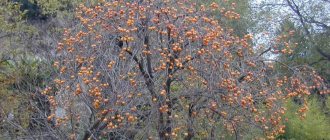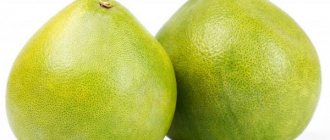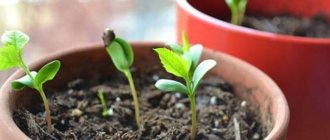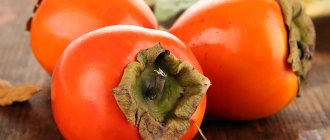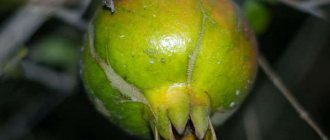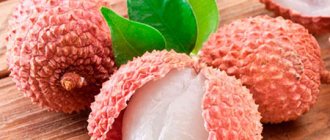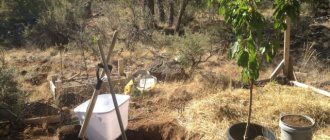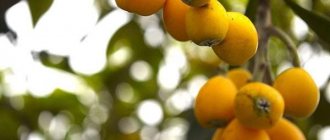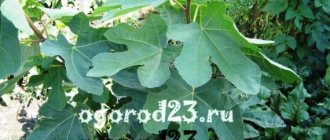Author of the article
Daria Vorontsova
Reading time: 7 minutes
AA
With the onset of cold weather, bright orange persimmon fruits appear on store shelves. The delicate sweetish taste of these berries with notes of honey and chocolate leaves no one indifferent. It is not surprising that to date more than 700 varieties of this sunny plant have been bred. Most of them are unpretentious in care and are characterized by high productivity. The article talks about how you can grow persimmons from seeds at home, the intricacies of care, as well as the beneficial properties of this tropical berry.
Appearance of persimmon
Date plum or persimmon is a woody plant of the Ebony family. In the wild it can reach 14 meters in height. At home, the size of the tree rarely exceeds 2 meters. Their growth is usually controlled by timely pruning. The fruits are large, fleshy, bright orange or red. The interesting pattern of the bark and the bends of the branches make it possible to grow persimmon as an ornamental plant. Dark green leaves create an openwork crown. Closer to leaf fall, their color can change from green to red.
Interesting! In addition to persimmons, on the shelves you can find fruits such as kinglet and sharon. The wren is a berry grown from male flowers. It differs from simple persimmon by the presence of seeds in the pulp, the absence of an astringent effect and the brownish pulp. Sharon is a hybrid of persimmon and apple. You can recognize this berry by its thin skin and denser pulp.
How and where persimmon grows in natural conditions
China is considered the birthplace of the plant. Specimens that were about 500 years old were discovered there. From China, orange berries began to be actively cultivated in Japan. Culture came to us only in the 19th century. Today these trees are grown in the southern regions of Europe, the Caucasus, Crimea, and America.
In open nature, trees can grow up to 7.5 m in height. The culture prefers well-lit places without drafts. In the regions native to persimmons, the fruits have time to ripen by the beginning of frost. If a tree grows in a harsher climate, it needs protection from freezing. Thanks to the work of breeders, cold-resistant varieties are being developed, which makes it possible to expand the growing area of persimmons.
Selection of planting material
In order to get strong shoots you need to choose the right planting material:
- The persimmon from which you plan to take seeds should not be overripe. You can check the degree of ripening by pressing your finger on the skin of the berry. It should bend easily, but not crumble into mush.
- Persimmon seeds die quickly at low temperatures. Therefore, even slightly frozen fruits are not suitable for germination.
- Unripe fruits can be kept in a warm, dark place until fully ripe.
- If traces of mold, black spots or rot are noticeable on the leaves of the fruit, then it is better to discard such seeds.
When growing persimmons at home, it is better to give preference to selected varieties. The most common types are Caucasian, Virginia and Eastern persimmons. Fuyu, Hiakume, Hachia, and Geili varieties have good taste. It is worth remembering that persimmon is a bisexual plant. Therefore, if a plant is planted for the purpose of harvesting, it is necessary to grow several trees at once. Self-pollinating varieties include: Nakhodka, Novinka, Sputnik, Mechta.
How to grow persimmons from seeds?
If you are not satisfied with long ceremonies with preliminary germination, you can immediately plant the seeds in a container with peat and clean river sand (1:1 proportions). Just before doing this, be sure to soak them for a couple of days in a solution of potassium permanganate. The more seeds you plant, the easier it will be to choose the strongest and most viable plants.
If you are thinking about which side to plant a persimmon seed, it is better to place it horizontally in the ground. There are no special rules here, but experienced gardeners recommend doing this process exactly this way.
If you place it vertically, then under comfortable conditions, I think it will also sprout, maybe a little later. You can also immediately take disposable plastic cups, make drainage holes in the bottom, and fill them with slightly moist fertile soil.
Remember that planting persimmons with seeds implies the presence of the “correct” substrate - it should be light and well aerated. It is optimal to mix two parts of leaf soil, plus one each of peat and sand. Or you can walk to the nearest flower shop and buy ready-made soil mixture for fruit trees. It already includes various “long-lasting” fertilizers, perlite, vermiculite, coconut fibers, coal, tree bark and other useful ingredients.
The persimmon seed should be buried no more than 1.5-2 cm, after which the pot or plastic tray should be covered with polyethylene (or glass) and placed closer to the radiator. Do not forget to regularly lift the protective covering, ventilate and water the soil. The first shoots should be expected in about 15-20 days.
Persimmon from the seed, photo:
If you are planting already germinated seeds (those that were previously placed in a bag), then the process of planting them is no different from that described above. The only thing is that everything should be done very carefully so as not to break off the sprout. When shoots appear in the pot, the plastic film can be removed. It often happens that the brown shell of the seed remains at the end of the sprout.
Seed shell on sprouts, photo:
It can sit quite firmly, pinching the top of the plant like a shell with its flaps. In this case, the sprout needs to be helped, otherwise it may die. Take a small knife or scissors, or even some kind of manicure tool and try to carefully remove the bone. If it does not give in, then spray the area with warm water from a spray bottle, cover the pot with plastic wrap and leave overnight (preferably closer to the heat). In the morning it can be easily removed.
Seed preparation
After the seeds are extracted from the pulp of the fruit, they need to be prepared for planting. The procedure takes place in several stages:
- The seeds are thoroughly washed with running water and soaked in a salty solution for several minutes. The floating grains are empty and are thrown away.
- The second stage is stratification. The washed, dried seeds are placed in a container with sand or peat chips and put in the refrigerator for 1.5 -2 months. The stratification procedure is best carried out during the natural wintering period of the plant - from mid-January to early March.
- Overwintered seeds are wrapped in damp gauze or a napkin and placed in a warm place for a week. During this period, it is necessary to regularly moisten the fabric to prevent it from drying out.
- The next step is scarification. The seed coat is carefully scratched or cut with a sharp object. It is very important not to damage the seed embryo.
- To strengthen immunity and accelerate growth, seeds are soaked for several hours in a solution of Epin or Zircon.
- At the last stage, the grains are disinfected with a weak solution of potassium permanganate or other antiseptic.
The seed preparation procedure takes a long time. But further success largely depends on how carefully it was carried out.
Will you be growing persimmons this season?
Of course not this time
Which persimmon seed to plant at home, how to select and process
Persimmon seeds or seeds, photo:
First you need to select the ideal seed. Opt for frost-resistant varieties (for example, “Rossiyanka”, “Virginskaya”), they are more hardened and unpretentious. Take the most beautiful and juicy fruit, ripe, but not overripe or frozen; its peel should be intact and undamaged. Here you need to make a small digression - it will be better and much more effective if, to select seeds, you take a fruit that grew in your region (if, of course, the climate allows it). Next, you need to put it in a warm place for several days, it will become completely soft and even begin to deteriorate a little - this is important.
After some time, the persimmon seed can be removed from the fruit, rinsed well with water and placed in a “bath” of slightly pink potassium permanganate for two days. This procedure is designed to disinfect the seed and identify non-viable specimens (spoiled seeds always float to the surface).
The next stage is how to germinate a persimmon seed; special preparations will help us here, such as Zircon, Ecopin, Ecosil, Novosil. You can also use aloe juice for these purposes; it is diluted with warm water (1 teaspoon per 100 ml of water).
Advice - if you want the seed to “wake up” as quickly as possible, carefully sand its sides with sandpaper or lightly scratch them with the point of a needle. Next, take clean gauze or a wide bandage, generously moisten it with the resulting solution, place persimmon seeds between layers of fabric and place everything in a plastic bag.
In order for the persimmon seed to germinate, the bag should be securely tied, but at the same time it should remain as if inflated, with air inside. Now you can put it in the refrigerator for about a couple of months. In the compartment where the seeds will be stored, it should be approximately +5..+7°C. If there is an arc processing method, the opposite of cold is heat, approximately +35..+40°C. To do this, the bag with the seed is placed closer to the radiator, where the sprouts will hatch in 7 or 10 days. Periodically inspect the contents of the bag to prevent the grains from drying out or becoming moldy.
Planting persimmons
Before planting, water the soil generously and allow it to soak in water. Seeds are planted 2=3 pieces horizontally, to a depth of 2-3 cm, sprinkled with soil and sprayed with a spray bottle. The container is covered with transparent film, glass or half a plastic bottle. The resulting greenhouse is placed in a warm, dark place for 1-1.5 months. Seedlings need to be ventilated daily for 10-15 minutes and irrigated with water, preventing the soil from drying out.
After the seeds germinate, open the container and transfer it to a sunny place. Sometimes the seed coat remains at the top of the plant. To remove it without damaging the plant, you need to moisten the shell with water and wait a couple of hours. The peel will soften and come off easily.
Persimmon grows quite quickly. After 3 pairs of true leaves appear, the plant can be transplanted into a pot of larger diameter. Transplantation is carried out using the transshipment method.
Helpful information
Daria Vorontsova
Amateur gardener. He is interested in growing various greens at home.
Persimmon is actively used in cooking. The sweet pulp gives a piquant taste to salads, juiciness and originality to meat dishes. Persimmons are dried, cut into slices and served as dessert.
Plant care
The key to a strong and healthy plant is compliance with basic rules of care, selection of optimal lighting and temperature conditions. It should be borne in mind that persimmon is a tropical plant. Therefore, it is better to create conditions for her that are close to her natural habitat.
Lighting and temperature conditions
Bright, diffused light is considered optimal for persimmons. The duration of daylight should be at least 8 hours. In winter, it is recommended to illuminate the plant with phytolamps. Exposing the seedling to direct sunlight for a long time can cause burns on the leaves.
The most suitable air temperature for active seedling growth is from 25 to 27 °C. Like any other plant, persimmon does not like drafts and temperature changes.
Humidity and watering
In order for the tree to feel good, it needs to be provided with high humidity. It is recommended to spray the leaves daily with a spray bottle; in hot weather, the amount can be increased to 3 times a day. Place a container of water or a humidifier next to the pot. In summer, you can move persimmons outdoors, to a place protected from direct sunlight.
Water the persimmon with warm, settled water. Watering is moderate without excessive waterlogging or drying out the soil.
During the dormant period, the plant is moved to a cool place and watering is reduced to once every 8 days. The signal about the beginning of hibernation is the complete fall of the leaves.
Top dressing
Persimmon categorically does not tolerate organic fertilizers with a high nitrogen content. During the active growth stage, potassium and phosphorus preparations can be added monthly as a top dressing. It is permissible to use preparations to fertilize fruit plants, reducing their concentration by 2 times from that recommended by the manufacturer. During the dormant period, fertilizing is not carried out.
Transfer
The first transplant is carried out after the appearance of the first true leaves. In the first 3 years, the plant is replanted annually, then as the pot fills with roots. The procedure is carried out using the transshipment method while preserving the earthen coma. The best time to change the container is the end of February or the beginning of March. In the first weeks after transshipment, the number of sprayings is increased. It is better to cover the soil surface with moss or sawdust. This helps create an optimal water balance in the soil.
Caring for persimmons in the first years of life
They begin to actively care for persimmons with the arrival of spring warmth. Until the tree develops intensively, it is replanted and placed in a lighted place.
The development of first-order branches is accompanied by the formation of a crown, which requires pinching, leaving shoots half a meter long. When shoots of the second order grow, pinching is carried out again.
Persimmon blooms for the first time 3-4 years after planting, if the crop overwintered in favorable conditions - cool. It is advisable to place the houseplant in the garden to create the possibility of pollination in nature.
If the persimmon seed grafting was successful, the first fruits will be expected after 3 years. If grown from seeds, fruits can be seen after 5-7 years. An adult culture does not require frequent replanting. It is advisable to change the top layer of the substrate annually. They choose the ideal place for the plant in the house so that the seedlings feel comfortable and receive sufficient lighting. Persimmon does not like direct rays of the sun, which cause burns to the foliage.
The requirement for watering is moderation. For indoor culture, it is important to create drainage in the vessel, which protects against water stagnation and infection of the plant. Occasionally, the leaves of the home tree are sprayed with lukewarm water. The seedlings are fed 2 times a month, alternating organic matter with a mineral complex. In the summer, the flowerpots are moved outside and onto the terrace, and in the fall they are brought into the room.
In the winter season, the main thing is to keep the persimmon cool. Growing at home is not always an easy task for beginners. Improper care often causes the death of a plant.
Plant pruning
In order for the persimmon to grow strong, healthy and please the eye with its appearance, it is necessary to regularly carry out sanitary and decorative pruning.
When the sprout reaches a height of 40-50 cm, pinch the top for the first time. To form the crown, 2 or 3 skeletal shoots are subsequently left. As the side shoots grow, their number is also reduced to 2-3 pieces. The optimal shoot length is 30-40 cm.
During sanitary pruning, weak, dry branches are removed and heavily thickened areas are thinned out. The procedure is carried out in spring and autumn. Decorative molding of the crown can be carried out at any time, except for the dormant stage of the plant.
Persimmon mask is an excellent cosmetic product. A large number of useful minerals and antioxidants improve complexion, relieve swelling and have a rejuvenating effect.
Pruning and temperature conditions
Do not doubt whether it is possible to grow persimmons at home from seeds. Of course it is possible, and many have already tried this method, it turned out to be quite successful. You cannot prune a tree before it reaches its optimal height. Then you can adjust the crown by removing its height and width. By maintaining the tree at this level, you can grow persimmons even in a small apartment. Choose a place for her where there is very good lighting and optimal temperature is maintained. It is very desirable that there are no drafts; this tree does not like cold air at all.
How to get the fruits
Most persimmon varieties are dioecious. This means that flowers of only one sex bloom on one tree. In order to get a harvest, you will need to carry out pollination between two plants of different sexes.
You can distinguish male flowers from female ones by their appearance. The first ones are small, collected in small inflorescences. Female flowers are large with a tart aroma and fleshy petals. Flowering occurs in mid-June, at the same time pollination takes place. To do this, a clean, dry brush with soft bristles is first passed over the male inflorescences, and then over the female ones. If everything is done correctly, after 1-2 weeks you can see the first ovaries. Full ripening of the fruit occurs by the end of October - beginning of November.
The first fruiting of a young seedling can be expected 5-6 years after planting. To reduce this period, gardeners vaccinate persimmons. The conditions for the procedure are a trunk thickness of at least 5 mm and a height of at least 15 cm. Fruit-bearing varieties of persimmon are used as a scion. It is not recommended to graft the plant onto other crops, as this may lead to a complete loss of the harvest in the future.
Growing persimmons from fresh seeds - where to start
To properly grow a berry tree at home or in the country, you need nutritious soil. The optimal soil is loose, fertilized, with a good soft structure and low acidity.
As a soil, you can take a turf layer mixed with vermiculite and sand.
The culture will take root only in a certain container - a ceramic pot with a diameter of at least 10 cm. The persimmon should be kept in it during the first growing season. Important! The culture is sensitive to stagnant water. To remove excess moisture, place broken pieces of pottery on the bottom of the container, and fill the top with soil. If you choose the wrong soil or container, there is a risk of rotting of the root system.
Possible difficulties when growing persimmons
The tree indicates errors in care by changing its appearance:
- Excessive moisture of the leaves leads to their yellowing.
- Lack of space in the pot can cause the seedling to stop growing.
- Sudden temperature changes and drafts can cause leaves to drop.
- Slow growth and lack of side shoots may be a consequence of poor soil and lack of fertilizing.
At home, persimmons are practically not susceptible to disease. The only danger can be mold and gray mold, which occurs due to excessive soil moisture. Prevention is to adjust the watering regime and ventilate the seedling in the fresh air.
If the soil is not treated before planting, there is a risk of seeing a web of mites or brown growths of scale insects on the persimmon leaves. In this case, the pests are removed manually, the tree is watered with Aktara or sprayed with Karbofos.
Seed selection
This is the most important point, since the entire further process of growth and development will depend on the degree of maturity and quality of the seed. You can purchase seeds through well-known agricultural companies. Then you will definitely be confident in the outcome of your seeding. However, you can go a more accessible route, that is, get seeds from ripe fruit. Be sure to choose a beautiful, soft fruit, without mold or severe external damage.
Useful properties of persimmon
Persimmon contains a large amount of useful substances and minerals. The amount of iron, calcium and manganese in this berry is several times higher than in apples. The high content of vitamin C makes persimmon a tasty remedy for the prevention and treatment of colds. There is more beta-carotene in fruits than in pumpkin, tomatoes and sweet peppers. This substance helps improve vision, complexion, and reduces the harm from nicotine use.
Persimmon contains a large amount of dietary fiber, which helps remove toxins from the body. This berry is an ideal product for those who are on a diet. It perfectly satisfies hunger and at the same time has low calorie content. There are only 70 kcal per 100 grams of product.
Magnesium, contained in the pulp of the fruit, helps strengthen the nervous system, helps fight depression and fatigue.
Helpful information
Daria Vorontsova
Amateur gardener. He is interested in growing various greens at home.
The astringent effect of persimmon is more pronounced in unripe fruits. You can get rid of it by putting the berries in the refrigerator or next to the apples for several hours.
Which variety is suitable for home use?
Persimmons were first cultivated in China. Now it is widespread, but few varieties are popular in domestic gardens and summer cottages.
Chocolate or Korolek
The variety is characterized by round fruits with an orange surface. The pulp is chocolate-colored. The berry contains 4-14 oblong seeds. Persimmon is distinguished by its juiciness, sweetness and lack of viscosity.
Honey or Tangerine
The fruit is similar to a tangerine, but only in shape. Its pulp has a honey flavor. The soft part is very sweet, painted in a bright orange hue. The fruit has no seeds at all.
Tomato or Ox's heart
There are no seeds here either. Soft and delicate persimmons are similar in appearance to a large tomato.
Common persimmon
An unremarkable variety. A wild species may occur. Strongly astringent to the mouth, the fruit is light orange in color.
Fig or Chamomile
Early ripening crop with brown pulp. The fruit contains several seeds. Very tasty, has a sweet aftertaste. The main feature is its interesting shape, like a pumpkin.
Chinese persimmon
A specific fruit with a hard skin, not too sweet. It is characterized by a specific shape with a stripe.
Egyptian elongated persimmon
The variety is not very different from the Chinese one, but the shape of the fruit is neat and beautiful. The color is bright orange. The taste is not the best: it is very astringent, not very sweet, with a hard skin. It is better to choose sweet, ripe fruits with a pleasant taste for home cultivation.
Today there are about 200 varieties of persimmon, differing in the size of the fruit part and taste properties.
For whom persimmon is contraindicated?
Like any other product, excessive consumption of persimmons can harm the body.
Tannin, which gives an astringent taste, has a fixing property. Therefore, people suffering from constipation and intestinal atony should eat persimmon with caution. For the same reason, the product should not be given to children under 3 years of age.
Long-term consumption of persimmon can cause a diuretic effect. It is contraindicated in acute inflammatory diseases of the urinary system. Persimmon is not recommended for diabetics due to its high sugar content.
Persimmon is a sunny berry with a bright taste. Growing and caring for this plant requires some effort and time. But the effort is worth it, because as a result you can get a beautiful ornamental tree with healthy and tasty fruits.
Soil preparation
For comfortable germination, ensure that the planting mixture is airy. You can buy ready-made planting material at a flower shop. The substrate contains equal parts of peat and sand.
It’s easy to make your own primer by mixing the ingredients. It is allowed to add fertilizer enriched with nutritional properties.
It is advisable to prepare the soil in advance so that the soil reaches room temperature and absorbs useful substances.
What is the difference between grafting a plant at home and outdoors?
Grafting persimmons growing at home or in greenhouses is not much different from the process for outdoor garden plants.
Both the seedling and the scion must belong to the same type of persimmon : garden persimmon, indoor or greenhouse - the same.
An imbalance between the scion and rootstock will lead to uneven bark growth on the grafted branch or bud; in addition, the rootstock may not be able to cope with the scion's demands for nutrients and water.
How to propagate indoor persimmons
Persimmon is propagated in three ways: cuttings, seeds and seedlings.
Cuttings
If you are the owner of a 5-year-old tree, choose young green branches without woodiness with three internodes. Then cut into cuttings at a right angle from above and beveled to the side from below, leaving a distance of 1 cm between the cut and the bud, and place in a growth stimulator (3 tablets per 1 liter of water) for 12 hours.
Watch the video on how to root cuttings into the soil
Seedlings
To grow fruit persimmon, buy a grafted seedling from a nursery in the fall. The main condition is not to keep the tree without soil for a long time. Make a depression in the soil 7-10 cm, lower the root. Then sprinkle with soil, press around the root with your hands and pour water at room temperature.
Seeds
The seed propagation method is the most convenient. If you bought persimmon fruits, collect the seeds, rinse and dry. Start germinating planting material in autumn or winter. At the end of February, beginning of March, plant the seeds in a box with prepared soil, then cover with polyethylene.
From seeds you can grow not only persimmons, but also large berries. Many people love watermelons, but do not know how to enjoy them for a long time. Look at how to properly store watermelons so that you can not only eat them, but also prepare seeds for next year.
Let me sum it up
When growing persimmons, I give some tips:
- In summer, take the plant out into the fresh air in a shaded place without wind.
- Water frequently, but do not allow water or dirt to stagnate in the pot.
- During the rest period, keep the plant in a dark place, occasionally check the condition of the soil and water the soil.
- During the growing season, feed with fertilizers, replant the plant as it grows and renew the top layer of soil.
Friends, growing persimmons may seem difficult to you. Believe me, if you follow agrotechnical rules and proper care, a branchy tree with small flowers and orange-colored fruits will grow in your apartment.
Types and varieties of persimmons for home growing on the windowsill
Persimmon combines evergreen and deciduous plants called ebony. Homeland Southeast Asia. There are three main types of persimmon: Caucasian, Eastern and Virgin, of which popular varieties for growing at home are presented in the table:
| Name | Brief characteristics of the tree | Special conditions |
| Seedles | Grows up to 10 m, large spherical crown and sparse branches | Frost-resistant, does not require pollination, requires crown formation |
| Hyakume | Growth up to 7 m with a dense spherical crown | Frost-resistant, does not require pollination |
| Chinubeli | Grows up to 1.5-2 m in height, resembles a shrub in appearance | Disease-resistant, frost-resistant, does not require pollination |
| Tamopan | A very tall representative of the eastern species up to 10 m | Frost-resistant, does not require pollination |
| Mount Hoverla | Grows up to 4 m in height, round-pyramidal crown | Frost-resistant, requires pollination |
| Midler | Grows up to 3-4 m in height, rounded-pyramidal crown | Self-pollinating, frost-resistant, disease resistant |
| Khuro-Kama | A representative of the eastern species grows up to 5 m | Frost-resistant, requires pollination |
The leaves of the ebony tree are rich green in color before falling, turning yellow then red and falling off, leaving a lonely, woody trunk. Therefore, persimmons are grown indoors as an ornamental plant. If you want to get not only exotic flowers in your apartment, but also fruits, choose the seeds of the self-pollinating variety Hiakume (Korolek).
What could be the rootstock?
The best rootstock for persimmons are trees of the same genus - that is, persimmons of a different variety. One of the best rootstocks for other varieties is Caucasian persimmon, as it produces a strong root system that is resistant to weather conditions.
Important!
Attention. Amateur gardeners sometimes use citrus or fig seedlings as rootstocks, but such experiments are fraught with the risk of producing a non-fruit-bearing plant.
When grafting persimmons, you must follow the “time to date” rule - you cannot graft early-ripening varieties onto a late-ripening scion, since their growing season and resistance to environmental conditions differ.
Can I use an apple tree for this or not?
It is recommended to graft persimmon onto a scion of the same kind, however, some gardeners resort to tricks and use apple, plum, sweet cherry, and sour cherries as rootstocks.
As a result, most often the result is poorly viable hybrids, which at best produce only foliage or begin to flower, but are incapable of fertilization. In addition, trees of different genera develop the bark and the trunk itself differently , so the rootstock may not withstand the thickness and weight of the scion.
Will a crop grown from a seed bear fruit without surgery?
Seeds obtained from persimmon are quite capable of further germination and fruiting of adult plants. This applies exclusively to non-hybrid varieties, since hybrids are sterile even when seeds are formed.
In addition, there is no absolute guarantee that trees grown from seed will bear fruit or even survive to the tree stage. Out of 10 seeds, on average, 6-8 seeds germinate ; usually 3-4 survive to the stage of a small seedling, and only 1 seed can subsequently grow into a large fruit-bearing tree. This is mainly due to violations of the conditions in which the seedlings are sown.
Advice
Persimmon is a very capricious plant in terms of propagation by seeds, and therefore grafting is a more reliable method of propagation.
Persimmon as a plant
China is considered the birthplace of this tree. There are more than two hundred varieties of persimmon. Not all of them can be eaten. The weight of the fetus can be from 80 to 550 grams. Size from 2 to 9 centimeters. There are no more than 10 seeds inside the fruit.
The plant is quite tall. It can grow from 6 to 12 meters. These are long-lived trees. On average they live up to 450 or even 500 years. In warm regions, a harvest of 250 kilograms can be harvested from one tree. Some varieties are valuable not only for their tasty and healthy fruits, but their wood is also considered valuable.
Nowadays, in addition to China, persimmons are successfully grown in countries such as:
- Georgia;
- Türkiye;
- Italy;
- Kazakhstan;
- Abkhazia and so on.
There are varieties that grow only in America and Australia. In Russia, persimmons are grown in the Krasnodar region, Crimea and Dagestan.
Optimal timing for the procedure
Persimmons are grafted before the flow of tree sap begins - in February-March, and in warm winters, sometimes in January. Earlier or later grafting may result in failure, since the scion may dry out without receiving nutrients from outside.
When choosing the timing of the rootstock, you need to focus on weather conditions and the condition of the cuttings and seedlings. It is important that the cuttings for the scion are as freshly cut as possible , since an impermeable film very quickly forms on the cut due to the connection of tree sap with oxygen.
